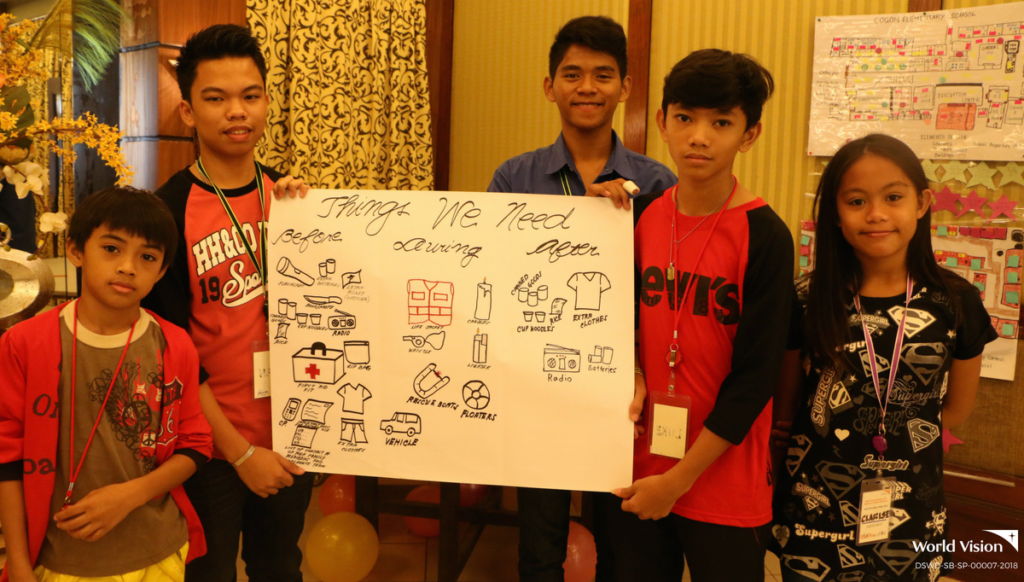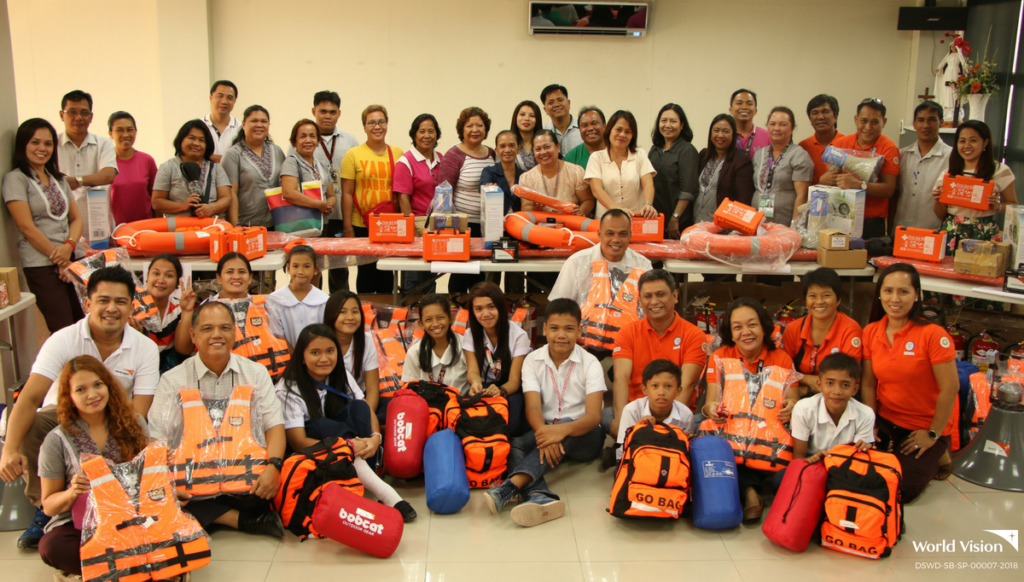Child-focused disaster risk reduction and management: Journeying with Tagbilaran City Schools

School authorities are becoming more intentional in engaging the students in DRR activities. Teachers and students are trained on doing hazard and risk maps, disaster timeline and other activities on separate sessions. The groups then join together for sharing of insights, giving both teachers and students the opportunity to express themselves. The said activities have resulted to more child-friendly and disaster-ready schools.
After over a year of capacitating Bohol educators in disaster risk reduction and management, World Vision handed over early warning devices to two schools as part of its commitment to help create safer schools for students.
The device and kits, which include hand-held radios, megaphones, life jackets, hard hats, life buoy rings and fire extinguishers were given based on their contingency plans.
More than the equipment
“More than the early warning device that we received, we are happy with how this project has guided us in doing our DRRM plans. We were not only able to comply with the mandate of the Department of Education but we were able to do it well,” said Jeremias Relator, DRRM Coordinator.
School authorities admitted the lack of DRRM technical know-how, hence,the difficulty in formulating the plan. The same struggle was true for the schools.
“We were not paying much attention to it because we didn’t know much. We conduct drills, yes, but mostly just for compliance. There wasn’t a clear plan, no direction,” shared Virgilia Omictin, head teacher.
The project, Humanitarian Partnership Agreement (HPA) Disaster Risk Reduction (DRR) and Disaster Risk Management (DRM) Capacity Building was implemented to address the said gaps. World Vision, in partnership with different government agencies, conducted several training and workshops on child-focused disaster risk reduction (CFDRR), first aid/emergency medical response, contingency planning and early warning system orientation. The whole project has directly benefitted more than 7,000 people.
Implementing the plan
Several months after the first wave of the project, the schools have marked different milestones.
“We now have an exit gate!” exclaimed 10-year old Hans. He was one of the student leaders of the Tagbilaran City Central School who attended the child-focused disaster risk reduction training. When he and his co-students were asked about the things that make them feel unsafe, they identified the lack of an exit gate.
His school houses more than 2,000 students. It has experienced several fire incidents, and the lack of exit gates made it more difficult to manage emergencies.
Aside from the exit gate, school ground levelling is also on-going. The uneven ground was determined to be child-unfriendly, especially during disasters. Evacuation signage has also been strategically posted around the campus. In the elementary school, the revamping of electric wires has been prioritised.
“This was pointed out during the risk assessment and so when we had our plan, we made sure that this will be given attention,” shared head teacher Elisa Geagonia. Other activities include expansion of pathways, exit gate construction and procurement of water tanks.

As part of its commitment to help create safer school for children, World Vision provided partner schools with emergency kit and early warning device. The city government also committed to provide other needed equipment to the schools, including an emergency vehicle that would be lodged in the Department of Education Regional Office.
Bringing stakeholders together
“We were intentional in having all stakeholders in the capacity building activities to make sure that we get everyone’s buy in and participation,” World Vision’s Operations Director, Xenia Legaspi said. This strategy has led to the collaboration of all stakeholders: from DRRM planning to implementation.
Assistant Principal, Proserpina Doroy emphasized, “One of the biggest impact this project has brought us is the levelling off of responsibilities of the local government unit, Parent-Teachers Association (PTA) and school authorities.”
The three schools’ exit gates, improved grounds and water tanks are all products of partnership with the barangay LGU and the PTA.
“After the plan, we immediately convened the PTA members. We explained the consequences of not having an exit gate to our children and that was when we agreed to support the construction of gate,” explained PTA President Androclues Pabe.
The DRRM plans were also instrumental in the immediate support of the local government.
“We were able to talk to the barangay authorities and lobby confidently because we have a plan to show,” added Pabe. Through the PTA members’ initiative, the local government authorities also committed to lending equipment like backhoe, road roller and other needed materials for the backfilling of school grounds.
One of the barangay council members shared, “After the training, we became more aware of our responsibility to the school, the students in particular. We were already supporting them prior to the project but not with DRRM initiatives. We’re thankful that you have included us in all the training, otherwise, we wouldn’t be as supportive as we are now.”
The city of Tagbilaran, on the other hand, expressed its gratitude for the accomplishments that came out of the project.
“We are thankful because this project has made our task easier. We are mandated to roll out RA10121 or the Philippines’ Disaster Management law but the reality is, there are only few of us and getting everyone on board is not as easy as it sounds. This project is an example of RA10121 spirit, highlighting multi-stakeholders partnership,” said City DRRM Coordinator Gerard Lavadia. The city government provided the school division office with a multicab designed for emergency purposes.
Ensuring sustainability
“You can be assured of the commitment of the Department of Education in the sustainability of this project. This is for our children,” said Schools Division Superintendent Virginia Zapanta.
Aside from school-based DRRM initiative, World Vision is also intentional in working at the community level. Children and community members are guided in conducting risk assessments and are empowered to present their recommendations to their respective DRRM council. If adopted, they will co-implement the agreed activities and projects. In 2017, there were 12,122 individuals from 23 communities that were involved in developing CF-DRRM plans, 9,311 of whom were children.
All for the welfare of the children
“We’ve seen a lot of changes after we were asked to contribute to the plan. We now have better school grounds, improved pathways, more emergency kits and we feel that we are consulted and involved,” replied 11-year old Monique when asked how she feels after the CFDRR training. The teachers, according to her have also become more steadfast in their efforts to prepare the students for whatever disaster that may happen.
PTA president Pabe ended, “It is easier for us to cooperate and contribute to this programme because our children will eventually benefit from it. As a parent, I want my children to be safe especially when I am not with them.”
—World Vision/June 25, 2018
Donate for Disaster Preparedness
Stay up to date with World Vision Philippines! Follow us on Facebook, Twitter and Instagram.








